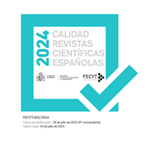Periodismo digital, paradigma del nuevo panorama interactivo
Resumen
Más o menos, se cumplen veinte años desde que los primeros medios hicieron su aparición en Internet. Esta doble década ha supuesto uno de los mayores cambios experimentados por la prensa en toda su historia. Desde que los periodistas conviven con Internet, la investigación, producción y difusión informativas han evolucionado totalmente. Incluso los propios perfiles del periodista, el medio y hasta el público han experimentado también cambios radicales. Durante lo que llevamos de siglo XXI, como ocurrió prácticamente desde la llegada de la televisión –y debido también a las publicaciones digitales, que son gratuitas–, los periódicos siguen perdiendo lectores y es raro no oír que el papel acabará desapareciendo. Esta investigación, que se enmarca en el campo de las ciencias sociales, pretende analizar y comparar el estilo y los contenidos de las ediciones digitales de dos de los periódicos nacionales más importantes de España, El País y El Mundo, analizando de manera cuantitativa y cualitativa sus ventajas e inconvenientes. El análisis permite concluir que los elementos apuntados son mecanismos de encuadre por los que los diarios transmiten enfoques de la realidad diferentes. Con esos mecanismos los diarios hacen opinión en la información. No obstante, nos preguntamos “¿Qué nuevas formas de comunicación se esconden en la prensa digital?”, “¿Deben los medios adaptarse a las nuevas circunstancias y cómo?” “¿Qué noticia que aparece en un diario es omitida por otros?”, “¿Qué es lo que destacan y minimizan estos diarios?”, “¿En qué coinciden y discrepan?”, “¿Hay diferencias en las “políticas de opinión” de los dos diarios?”, “¿Hay diferencias en los estilos argumentativos de los editoriales?”.Descargas
Descarga artículo
Licencia
La revista Estudios sobre el Mensaje Periodístico, para fomentar el intercambio global del conocimiento, facilita el acceso sin restricciones a sus contenidos desde el momento de su publicación en la presente edición electrónica, y por eso es una revista de acceso abierto. Los originales publicados en esta revista son propiedad de la Universidad Complutense de Madrid y es obligatorio citar su procedencia en cualquier reproducción total o parcial. Todos los contenidos se distribuyen bajo una licencia de uso y distribución Creative Commons Reconocimiento 4.0 (CC BY 4.0). Esta circunstancia ha de hacerse constar expresamente de esta forma cuando sea necesario. Puede consultar la versión informativa y el texto legal de la licencia.










